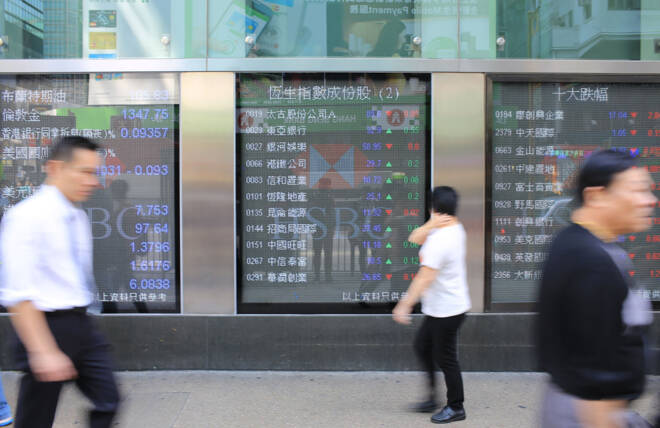Advertisement
Advertisement
Hang Seng Index and Nikkei 225 Diverge on Tariff Worries, AI Optimism
By:
Key Points:
- Hang Seng slid 1.33% as Trump’s tariff threats hit Chinese markets; tech and real estate stocks led losses.
- Nikkei climbed 1.48% on AI optimism and a weaker Yen; Softbank surged 9.16% on Trump’s Stargate joint venture.
- ASX 200 rose 0.31% as banking stocks gained, but mining giants fell on renewed China tariff concerns.
US Markets Advance Amid Optimism Over Trump Policies
US markets started the week on a positive note, driven by market reactions to US President Trump’s new policies. The Nasdaq Composite Index gained 0.64% on Tuesday, January 21, while the Dow and the S&P 500 rallied 1.24% and 0.88%, respectively.
In the bond markets, 10-year US Treasury yields retreated further from the January 14 high of 4.809%, boosting demand for riskier assets. The pullback in yields reflected investor bets on a more dovish Fed rate path. Lower borrowing costs may boost company earnings and valuations.
On Tuesday, President Trump announced a new joint venture (JV) named ‘Stargate,’ comprising OpenAI, Oracle (ORCL), and SoftBank. The news underscored Trump’s focus on the AI and the broader tech sectors. There was also market relief that President Trump held back a rollout of sweeping tariffs.
Tuesday’s gains set the stage for Wednesday’s Asian session.
Trump’s China Tariff Considerations Weigh on Markets
On Wednesday, January 22, news of US President Trump considering tariffs on China spooked investors. CN Wire reported:
“Donald Trump announced plans to impose a 10% tariff on China, potentially effective February 1, citing fentanyl exports from China to Mexico and Canada as the reason. Trump stated he had discussed the issue with Chinese President Xi Jinping, who called for cooperation and emphasized the mutual benefits of U.S.-China economic ties. Meanwhile, China’s Vice Premier Ding Xuexiang warned against trade wars at the World Economic Forum, advocating for economic globalization.”
The latest news underscored the need for more consumption-related stimulus measures to shift further toward a consumption-driven economy.
Trump’s proposed tariffs followed China’s impressive trade data for December. China’s combined value of imports and exports exceeded CNY4 trillion for the first time in December, potentially drawing Trump’s attention.
Natixis Asia Pacific Chief Economist Alicia Garcia Herrero remained optimistic, stating,
China is the most well-prepared country for the Trump administration because it faces the largest exposure. It is initially clear that China is the winner as Trump is considering visiting the country in his first 100 days in office.”
Hang Seng Index Slides on Tariff Threats
The Hang Seng Index slid by 1.33% on Wednesday morning as investors reacted to Trump’s renewed threat of tariffs, which overshadowed his AI initiatives. US tariffs could affect demand for Chinese goods, China’s trade terms, and its economy. Real estate and tech stocks contributed to the losses.
The Hang Seng Tech Index dropped by 1.89%. Tech giant JD.com (9618) tumbled 4.55%, while Alibaba (9988) was down 2.36%. Similarly, the Hang Seng Mainland Properties Index slid by 2.01%.
Mainland China’s equity markets also posted morning losses, with the CSI 300 and the Shanghai Composite falling 0.68% and 0.62%, respectively. However, hopes for government stimulus to boost consumption limited the downside.
Nikkei Rallies on AI Joint Venture News
Japan’s Nikkei Index rallied 1.48% on Wednesday morning. Investors reacted to Trump’s AI initiatives and the absence of sweeping tariffs. A weaker Japanese Yen bolstered demand for Japanese stocks, as the USD/JPY pair rose 0.19% to 155.781. Yen weakness could boost overseas earnings and valuations.
Major gainers included Softbank (9984), which surged 9.16% on news of the company entering the Stargate JV. Tokyo Electron (8035) advanced by 2.31%, while Nissan Corp. (7201) gained 1.54%, reflecting investor confidence in export-driven sectors.
ASX 200 Rises Amid Banking and Tech Sector Gains
Australia’s ASX 200 Index climbed by 0.31% on Wednesday morning. Banking and tech stocks contributed to the gains. However, a pullback in mining and oil stocks capped the upside.
Notable movers included the Commonwealth Bank of Australia (CBA) and National Australia Bank (NAB), which posted gains of 0.52% and 0.67%, respectively. Bank stocks benefited from the overnight fall in US Treasury yields, which boosted demand for high-yielding Australian banks.
However, mining giants BHP Group Ltd. (BHP) and Rio Tinto Ltd. (RIO) dropped by 1.72% and 0.60%, respectively. Renewed tariff threats on China pressured iron ore spot prices, impacting mining stocks.
Outlook: Risks and Opportunities
Global markets remain volatile as geopolitical and economic uncertainties persist following Trump’s inauguration. Key factors include:
- US-China relations and tariff developments.
- Shifts in Fed rate expectations and US economic trends.
- AI initiatives and their potential market impact.
- China’s stimulus moves to boost domestic demand and consumption.
While cautious central bank policies may stabilize markets, investors should closely monitor trade dynamics, inflation trends, and monetary signals to navigate ongoing market volatility. Discover strategies to navigate this week’s market trends here.
About the Author
Bob Masonauthor
With over 28 years of experience in the financial industry, Bob has worked with various global rating agencies and multinational banks. Currently he is covering currencies, commodities, alternative asset classes and global equities, focusing mostly on European and Asian markets.
Did you find this article useful?
Latest news and analysis
Advertisement
